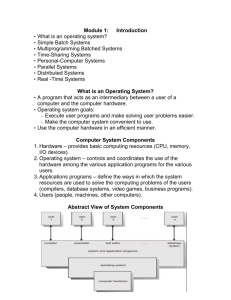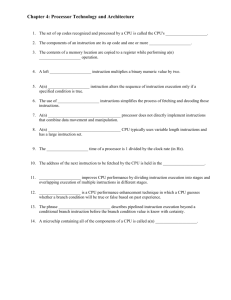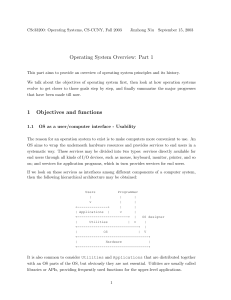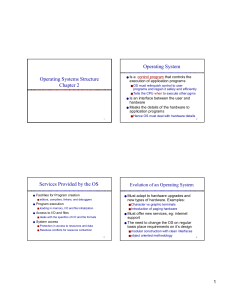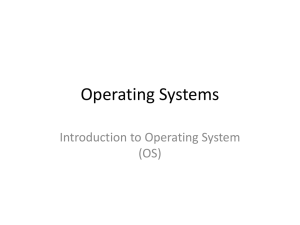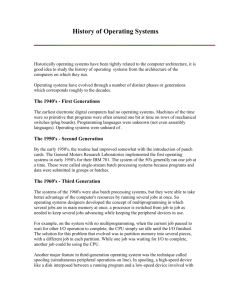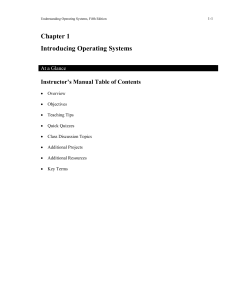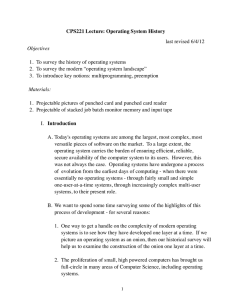Chapter 1 Introducing Operating Systems
advertisement
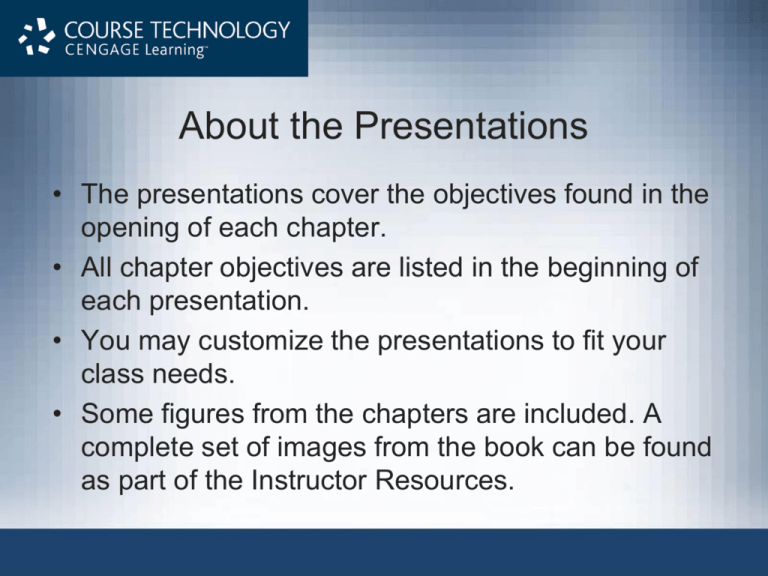
About the Presentations • The presentations cover the objectives found in the opening of each chapter. • All chapter objectives are listed in the beginning of each presentation. • You may customize the presentations to fit your class needs. • Some figures from the chapters are included. A complete set of images from the book can be found as part of the Instructor Resources. Understanding Operating Systems Seventh Edition Chapter 1 Introducing Operating Systems Learning Objectives After completing this chapter, you should be able to describe: • Innovations in operating systems development • The basic role of an operating system • The major operating system software subsystem managers and their functions • The types of machine hardware on which operating systems run Understanding Operating Systems, 7e 3 Learning Objectives (cont'd.) • The differences among batch, interactive, real-time, hybrid, and embedded operating systems • Design considerations of operating systems designers Understanding Operating Systems, 7e 4 Introduction • Operating systems – Manage computer system hardware and software • This text explores: – – – – What they are How they work What they do Why they do it • This chapter briefly describes: – Workings of operating systems Understanding Operating Systems, 7e 5 What Is an Operating System? • Computer system – Software (programs) – Hardware (tangible machine/electronic components) • Operating system – Chief software component – Manages all hardware and all software and controls: • Every file, device, section of main memory, and moment of processing time • Who can use the system and how system is used Understanding Operating Systems, 7e 6 Operating System Software • Includes four essential subsystem managers – – – – Memory Manager Processor Manager Device Manager File Manager • Each manager: – Works closely with other managers – Performs a unique role Understanding Operating Systems, 7e 7 Operating System Software (cont'd.) (figure 1.1) This pyramid represents an operating system on a stand-alone computer unconnected to a network. It shows the four subsystem managers and the user interface. © Cengage Learning 2014 Understanding Operating Systems, 7e 8 Operating System Software (cont'd.) • User Interface – Allows the user to issue commands to the operating system • Manager tasks – Monitor the system’s resources continuously – Enforce policies determining: • Who gets what, when, and how much – Allocate a resource (when appropriate) – Deallocate a resource (when appropriate) Understanding Operating Systems, 7e 9 (figure 1.2) Each manager at the base of the pyramid takes responsibility for its own tasks while working harmoniously with every other manager. © Cengage Learning 2014 Understanding Operating Systems, 7e 10 Operating System Software (cont'd.) • Network Manager – Coordinates the services required for multiple systems to work cohesively together • Shared network resources: memory space, processors, printers, databases, applications, etc. Understanding Operating Systems, 7e 11 Main Memory Management • In charge of main memory – Random access memory (RAM) • Requires constant flow of electricity to hold data • Responsibilities include: – Checking validity and legality of memory space request – Reallocating memory to make more useable space available – Deallocating memory to reclaim it – Protecting space in main memory occupied by operating system Understanding Operating Systems, 7e 12 Main Memory Management • Read-only memory (ROM) – Another type of memory – Critical when computer is powered on – Holds firmware: programming code • When and how to load each piece of the operating system after the power is turned on – Non-volatile • Contents retained when the power is turned off Understanding Operating Systems, 7e 13 Processor Management • In charge of allocating Central Processing Unit (CPU) • Tracks process status – Program’s “instance of execution” • Comparable to a traffic controller – When a process is finished or maximum computation time expired • Processor Manager reclaims the CPU and allocates to next waiting process – Computer with multiple CPUs • More complex management Understanding Operating Systems, 7e 14 Device Management • In charge of connecting with every available device – Printers, ports, disk drives, etc. • Responsibilities include: – Choosing most efficient resource allocation method • Based on scheduling policy – – – – Identifying each device uniquely Starting device operation (when appropriate) Monitoring device progress Deallocating the device • What is the function of a device driver? Understanding Operating Systems, 7e 15 File Management • In charge of tracking every file in the system – Data files, program files, compilers, application programs, etc. • Responsibilities include: – Enforcing user/program resource access restrictions • Uses predetermined access policies – Controlling user/program modification restrictions • Read-only, read-write, create, delete – Allocating space for a file on secondary storage • One large storage area or smaller linked pieces – Retrieving files efficiently Understanding Operating Systems, 7e 16 Network Management • Included in operating systems with networking capability • Authorizes users to share resources – Overall responsibility for every aspect of network connectivity • Devices, files, memory space, CPU capacity, etc. Understanding Operating Systems, 7e 17 User Interface • Portion of the operating system – Direct interaction with users • Two primary types – Graphical user interface (GUI) • Input from pointing device • Menu options, desktops, and formats vary – Command line interface • Keyboard-typed commands that display on a monitor • Strict requirements for every command: typed accurately; correct syntax; combinations of commands assembled correctly Understanding Operating Systems, 7e 18 Cooperation Issues • No single manager performs tasks in isolation • Each element of an operating system – Performs individual tasks and – Harmoniously interacts with other managers • Incredible precision required for operating system to work smoothly • More complicated when networking is involved Understanding Operating Systems, 7e 19 Cloud Computing • Practice of using Internet-connected resources – Performing processing, storage, or other operations • Operating system maintains responsibility – Managing all local resources and coordinating data transfer to and from the cloud • Role of the operating system – Accessing resources – Managing the system efficiently Understanding Operating Systems, 7e 20 An Evolution of Computing Hardware • Hardware: physical machine and electronic components – Main memory (RAM) • Data/Instruction storage and execution – Central processing unit (CPU) • Controls interpretation and execution of instructions • Initiates or performs these operations: storage, data manipulation and input/output – Input/output devices (I/O devices) • All peripheral devices in the system: printers, disk drives, CD/DVD drives, keyboards, etc. Understanding Operating Systems, 7e 21 An Evolution of Computing Hardware (cont'd.) • Computer classification – At one time: based on memory capacity • Current platforms (table 1.1) A brief list of platforms and a few of the operating systems designed to run on them, listed in alphabetical order. Understanding Operating Systems, 7e Understanding Operating Systems, 7e 22 An Evolution of Computing Hardware (cont'd.) • Moore’s Law: Gordon Moore, 1965 – Each new processor chip compared to its predecessor • Twice as much capacity • Released within 18-24 months Understanding Operating Systems, 7e 23 An Evolution of Computing Hardware (cont'd.) (figure 1.6) Gordon Moore’s 1965 paper included the prediction that the number of transistors incorporated in a chip will approximately double every 24 months [Moore, 1965]. Courtesy of Intel Corporation. Understanding Operating Systems, 7e 24 Types of Operating Systems • Five categories – – – – – Batch Interactive Real-time Hybrid Embedded • Two distinguishing features – Response time – Method of data entry into the system Understanding Operating Systems, 7e 25 Types of Operating Systems (cont'd.) • Batch systems: jobs entered as a whole and in sequence – Input relied on punched cards or tape – Efficiency measured in throughput • Interactive systems: allow multiple jobs – Faster turnaround than batch systems – Slower than real-time systems – Introduced to provide fast turnaround when debugging programs – Complex algorithms: share processing power Understanding Operating Systems, 7e 26 Types of Operating Systems (cont'd.) • Real-time systems – Reliability is critical – Used in time-critical environments • Spacecraft, airport traffic control, fly-by-wire aircraft, critical industrial processes, medical systems, etc. – Two types of real-time systems • Hard real-time systems: risk total system failure if the predicted time deadline is missed • Soft real-time systems: suffer performance degradation as a consequence of a missed deadline Understanding Operating Systems, 7e 27 Types of Operating Systems (cont'd.) • Hybrid systems – Combination of batch and interactive – Light interactive load • Accepts and runs batch programs in the background • Network operating systems – Special class of software • Users perform tasks using few, if any, local resources, e.g., cloud computing – Wireless networking capability • Standard feature in many computing devices: cell phones, tablets, and other handheld Web browsers Understanding Operating Systems, 7e 28 (figure 1.7) Example of a simple network. The server is connected by cable to the router and other devices connect wirelessly. © Cengage Learning 2014 Understanding Operating Systems, 7e 29 Types of Operating Systems (cont'd.) • Embedded systems – Computers placed inside other products • Automobiles, digital music players, elevators, pacemakers, etc. – Adds features and capabilities – Operating system requirements • Perform specific set of programs • Non-interchangeable among systems • Small kernel and flexible function capabilities Understanding Operating Systems, 7e 30 Brief History of Operating Systems Development • Evolution of operating systems: parallels evolution of computer hardware • 1940s – Computers operated by programmers presiding from the main console – Fixing a program error • 1) stop the processor; 2) read register contents; 3) make corrections in memory; 4) resume operations – Poor machine utilization • CPU processed data and performed calculations for fraction of available time – “Bug”: system not working correctly Understanding Operating Systems, 7e 31 (figure 1.8) Dr. Grace Hopper’s research journal included the first computer bug, the remains of a moth that became trapped in the computer’s relays, causing the system to crash. [Photo © 2002 IEEE] Understanding Operating Systems, 7e 32 Brief History of Operating Systems Development (cont'd.) • 1950s: second generation – Two widely adopted improvements • Computer operators: humans hired to facilitate machine operation • Job scheduling: programs with similar requirements grouped together (batch) – Expensive time lags between CPU and I/O devices – Improvements to the CPU and the system • I/O devices (tape drives and disks): gradually became faster Understanding Operating Systems, 7e Understanding Operating Systems, 7e 33 Brief History of Operating Systems Development (cont'd.) • 1950s – Improvements to the CPU and the system • Records blocked before retrieval or storage • Control unit placed between I/O and CPU as a buffer: reduced speed discrepancy • 1960s – Faster CPUs – Speed caused problems with slower I/O devices Understanding Operating Systems, 7e Understanding Operating Systems, 7e 34 Brief History of Operating Systems Development (cont'd.) • 1960s – Multiprogramming: many programs loaded and sharing the CPU • Passive multiprogramming: interrupts • Active multiprogramming: time slicing • 1970s – Faster CPUs: caused problems with slower I/O devices – Main memory physical capacity limitations • Multiprogramming schemes: increase CPU use • Virtual memory system: solves physical limitation Understanding Operating Systems, 7e Understanding Operating Systems, 7e 35 Brief History of Operating Systems Development (cont'd.) • 1980s – More flexible hardware • Logical functions built on replaceable circuit boards – Operating system functions • Made part of the hardware (firmware) – Multiprocessing: more than one processor • Allowed parallel program execution – Evolution of personal computers and high-speed communications • Led to distributed processing/networked systems Understanding Operating Systems, 7e 36 Brief History of Operating Systems Development (cont'd.) • 1990s – Demand for Internet capability – Increased networking – Increased tighter security demands • Protect system assets from Internet threats – Multimedia applications • Demanded additional power, flexibility, device compatibility for most operating systems, etc. Understanding Operating Systems, 7e 37 (figure 1.11) Illustration from the 1989 proposal by Tim BernersLee describing his revolutionary “linked information system.” Understanding Operating Systems, 7e 38 Brief History of Operating Systems Development (cont'd.) • 2000s – Need for improved flexibility, reliability, and speed – Virtual machines • Accommodated multiple operating systems that run at the same time and share resources • Required OS to have an intermediate manager – Oversee the access of each operating system to the server’s physical resources – Multicore processors: two to many cores • What capabilities does the operating system need for these processors? Understanding Operating Systems, 7e 39 Brief History of Operating Systems Development (cont'd.) • 2010s – Increased mobility and wireless connectivity • Proliferation of dual-core, quad-core, and other multicore CPUs – Multicore technology • Single chip equipped with two or more processor cores • What is the advantage over chips with transistors in close proximity? Understanding Operating Systems, 7e 40 Design Considerations • Most common overall goal – Maximize use of the system’s resources (memory, processing, devices, and files) and minimize downtime • Factors included in developmental efforts – – – – – RAM resources CPUs: number and type available Peripheral devices: variety likely to be connected Networking capability Security requirements, etc. Understanding Operating Systems, 7e 41 Conclusion • Overall function of operating systems • Evolution of operating systems – Capable of running complex computers and computer systems • Operating system designer – Chooses the policies that best match the system’s environment Understanding Operating Systems, 7e 42
